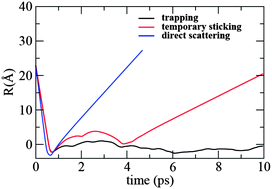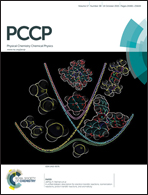Mechanistic details of energy transfer and soft landing in ala2-H+ collisions with a F-SAM surface
Abstract
Previous chemical dynamics simulations (Phys. Chem. Chem. Phys., 2014, 16, 23769–23778) were analyzed to delineate atomistic details for collision of N-protonated dialanine (ala2-H+) with a C8 perfluorinated self-assembled monolayer (F-SAM) surface. Initial collision energies Ei of 5–70 eV and incident angles θi of 0° and 45°, with the surface normal, were considered. Four trajectory types were identified: (1) direct scattering; (2) temporary sticking/physisorption on top of the surface; (3) temporary penetration of the surface with additional physisorption on the surface; and (4) trapping on/in the surface, by physisorption or surface penetration, when the trajectory is terminated. Direct scattering increases from 12 to 100% as Ei is increased from 5 to 70 eV. For the direct scattering at 70 eV, at least one ala2-H+ heavy atom penetrated the surface for all of the trajectories. For ∼33% of the trajectories all eleven of the ala2-H+ heavy atoms penetrated the F-SAM at the time of deepest penetration. The importance of trapping decreased with increase in Ei, decreasing from 84 to 0% with Ei increase from 5 to 70 eV at θi = 0°. Somewhat surprisingly, the collisional energy transfers to the F-SAM surface and ala2-H+ are overall insensitive to the trajectory type. The energy transfer to ala2-H+ is primarily to vibration, with the transfer to rotation ∼10% or less. Adsorption and then trapping of ala2-H+ is primarily a multi-step process, and the following five trapping mechanisms were identified: (i) physisorption–penetration–physisorption (phys–pen–phys); (ii) penetration–physisorption–penetration (pen–phys–pen); (iii) penetration–physisorption (pen–phys); (iv) physisorption–penetration (phys–pen); and (v) only physisorption (phys). For Ei = 5 eV, the pen–phys–pen, pen–phys, phys–pen, and phys trapping mechanisms have similar probabilities. For 13.5 eV, the phys–pen mechanism, important at 5 eV, is unimportant. The radius of gyration of ala2-H+ was calculated once it is trapped on/in the F-SAM surface and trapping decreases the ion's compactness, in part by breaking hydrogen bonds. The ala2-H+ + F-SAM simulations are compared with the penetration and trapping dynamics found in previous simulations of projectile + organic surface collisions.


 Please wait while we load your content...
Please wait while we load your content...